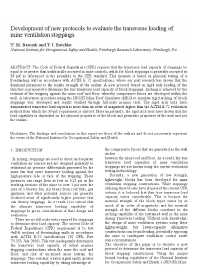Mining Publication: Development of New Protocols to Evaluate the Transverse Loading of Mine Ventilation Stoppings
Original creation date: June 2006
The Code of Federal Regulations (CFR) requires that the transverse load capacity of stoppings be equal to or greater than traditionally accepted in mine controls. For block stoppings, this is generally accepted as 39 psf, as referenced in the preamble to the CFR standard. This measure is based on physical testing of a freestanding wall in accordance with ASTM E72 specifications, where our past research has shown that the dominant parameter is the tensile strength of the sealant. A new protocol based on rigid arch loading of the structure is proposed to determine the true transverse load capacity of block stoppings. Arching is achieved by the restraint of the stopping against the mine roof and floor whereby compressive forces are developed within the wall. A laboratory procedure using the NIOSH Mine Roof Simulator to simulate rigid arching of block stoppings was developed and results verified through full-scale in-mine tests. The rigid arch tests have demonstrated transverse load capacities more than an order of magnitude higher than the ASTM E72 evaluation method from which the 39-psf requirement is derived. More importantly, the rigid arch tests have shown that the load capability is dependent on the physical properties of the block and geometric properties of the wall, not the sealant.
Authors: TM Barczak, TJ Batchler
Conference Paper - June 2006
NIOSHTIC2 Number: 20030339
Proceedings of the 11th U.S./North American Mine Ventilation Symposium, University Park, Pennsylvania, June 5-7, 2006. Mutmansky JM, Ramani RV. eds., London, U.K.: Taylor & Francis Group, 2006 Jun; :569-577
See Also
- Advances in Grid-Based Numerical Modeling Techniques for Improving Gas Management in Coal Mines
- Comparison of the Transverse Load Capacities of Various Block Ventilation Stoppings under Arch Loading Conditions
- Degasification System Selection for U.S. Longwall Mines Using an Expert Classification System
- Explosion Effects on Mine Ventilation Stoppings
- Lowering Respirable Dust at an Iron Ore Concentrator Plant Through Improved Ventilation Practices
- Technology News 500 - Using In-Place Stone Stoppings to Direct Air in Underground Stone Mines
- Technology News 518 - Super Stopping: A Permanent Solid Stopping for Directing Ventilation Airflows in Large-opening Metal/Nonmetal Mines
- Technology News 519 - EZ-Up Curtain Stoppings: A Practical Solution for Directing Ventilation Airflows in Large-opening Metal/Nonmetal Mines
- Testing and Evaluation of an Inflatable Temporary Ventilation Control Device
- Ventilation Planning Layouts for Large Opening Mines
- Page last reviewed: 9/21/2012
- Page last updated: 9/21/2012
- Content source: National Institute for Occupational Safety and Health, Mining Program


 ShareCompartir
ShareCompartir
